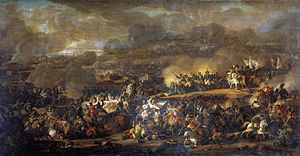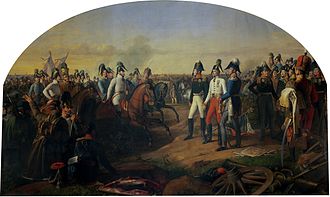Battle of Leipzig
Battle of Leipzig
Part of: Wars of Liberation

Battle of the Nations near Leipzig
(Painting by Vladimir Moschkov, 1815)
Battles of the Wars of Liberation (1813-1815)
Spring campaign 1813Lüneburg
- Möckern - Halle - Großgörschen - Gersdorf - Bautzen - Reichenbach - Nettelnburg - Haynau - Luckau
Autumn campaign 1813Großbeeren
- Katzbach - Dresden - Hagelberg - Kulm - Dennewitz - Göhrde - Altenburg - Wittenberg - Wartenburg - Liebertwolkwitz - Leipzig - Torgau - Hanau - Hochheim - Danzig
Winter campaign 1814Épinal
- Colombey - Brienne - La Rothière - Champaubert - Montmirail - Château-Thierry - Vauchamps - Mormant - Montereau - Bar-sur-Aube - Soissons - Craonne - Laon - Reims - Arcis-sur-Aube - Fère-Champenoise - Saint-Dizier - Claye - Villeparisis - Paris
Summer campaign of 1815Quatre-Bras
- Ligny - Waterloo - Wavre - Paris
The Battle of the Nations near Leipzig from 16 to 19 October 1813 was the decisive battle of the Wars of Liberation. The troops of the allies, essentially Russia, Prussia, Austria and Sweden, fought against Napoleon Bonaparte's troops.
With up to 600,000 soldiers from over a dozen countries involved, this battle was probably the largest battle in world history until the beginning of the 20th century. In this most important battle of the War of Liberation against Napoleonic rule, the numerically superior allied armies of the Russians, Prussians, Austrians, and Swedes inflicted the decisive defeat on Napoleon Bonaparte, forcing him to withdraw from Germany with the remaining army and without allies.
In the battle, 92,000 of the approximately 600,000 soldiers involved were killed or wounded.
To mark the one hundredth anniversary, the 91-metre-high Monument to the Battle of the Nations was completed in Leipzig in 1913. This landmark was erected near the area where the fiercest fighting took place and where most of the soldiers fell.

Karl Philipp Fürst zu Schwarzenberg announces the victory in the Battle of the Nations at Leipzig to the allied monarchs. Painting by Johann Peter Krafft, 1817, Museum of Military History Vienna.
_b_668.jpg)
Overview of the battlefield Illustration for the 50th anniversary of the battle from the Gartenlaube, October 1863. (Caption)
Naming
Achim von Arnim was the first to call the event the "Battle of the Nations" in an article published in the Berlin daily newspaper Der Preußische Correspondent on 22 October 1813. He may have been thinking of the legend of the "Battle of the Nations at the Birch Tree", which prophesied an eschatological "Battle of the Nations" in Westphalia, in which "Russia, Sweden and the whole North" and "France, Italy, Spain and the whole South" would be pitted against each other. In the summer of 1813, the idea that this "great battle of the nations" was now imminent as a decisive battle against Napoleon was so common in view of the political-military situation, at least in the circle around Arnim, that he predicted it in a letter of 14 September even until the end of 1813.
On October 25, Der Preußische Correspondent published the Ninth Army Report of the Silesian Army of October 19, in which the reporter Karl von Müffling also referred to the battle as the "Battle of the Nations." As a meanwhile discovered army report in leaflet form shows, Müffling used there "Volksschlacht" instead of "Völkerschlacht". Arnim, who first published the pamphlet, apparently added some words to the report and, like "Volksschlacht," changed them. The newspapers of the time then reprinted Arnim's text rather than that of the pamphlet. Henrich Steffens, on the other hand, remembers that the approach of the Bohemian army, observed from a distance, seized Blücher's staff with "great violence." One compared it with the migration of nations and Müffling had already called the forthcoming battle "Völkerschlacht".
Although other contemporaries used the word "Battle of the Nations" as early as October 1813 and it quickly became established, it was predominantly in the descriptive sense "... near Leipzig". The official term "Battle of Leipzig" predominated in German journalism until "Battle of the Nations" became established at the time of the erection of the Monument to the Battle of the Nations on the occasion of its centenary.
Due to the large number of nations involved, the battle is also known as the Battle of Many Nations.
Previous story
After Napoleon's disastrous defeat in the Russian campaign of 1812, General Yorck, who commanded the Prussian auxiliary corps, concluded the Convention of Tauroggen with the Russian General Diebitsch on 30 December 1812. This put an end to hostilities between Prussia and Russia. The Austrian Auxiliary Corps under General Schwarzenberg concluded an armistice with the Russians on January 30, 1813, Austria having previously declared to Napoleon that it would in no case increase the strength of the contingent of troops for France. On February 28 Russia and Prussia signed a treaty of alliance, and on March 16 declared war on France. Already on February 24 there had been uprisings in Hamburg against the French occupation, and Russian troops marched into Hamburg on March 18, but were soon forced to vacate the city. On March 19, the Russian tsar and the Prussian king issued a proclamation to the Germans, including especially the German princes, calling on them to join the struggle against France and declaring the Confederation of the Rhine dissolved. Only Mecklenburg heeded this call; all other rulers still feared Napoleon. Austria remained neutral and, in a mediating role, sought a peaceful solution to the conflict, but made it clear that if negotiations failed, it would intervene militarily. Saxony signed an alliance with Austria on 26 April.
On April 29 and 30, the French troops crossed the Saale near Merseburg and Weißenfels. They had 150,000 men at their disposal at that time. Opposing them at this time were only 43,000 Prussians and 58,000 Russians. After the battle of Möckern on April 5, 1813, the Saxon king had changed sides and placed his army under Napoleon's command. In the battles that followed, both sides suffered heavy losses. An armistice was agreed on June 4, and Russian and Prussian troops withdrew to Silesia. Austria concluded an alliance with Russia and Prussia on June 24, but this was to be valid only if negotiations with Napoleon failed. For further negotiations Austrian Chancellor Metternich met Napoleon in Dresden on June 26, and the armistice was extended until August 10. On August 10, Austria broke off the negotiations, as no agreement was reached and Napoleon obviously just wanted to buy time. On August 12, Austria declared war on France. The force of the coalition under the leadership of the Austrian Field Marshal Karl Philipp zu Schwarzenberg had crossed the Oder on August 11 and resumed the war. Both sides had used the armistice to recruit soldiers and bring in reinforcements. Napoleon now had 442,000 men, 40,000 of them cavalry. Opposing him were 184,000 Russians, 160,000 Prussians, 127,000 Austrians, 23,000 Swedes, 6,000 Mecklenburgers, and another 9,000 from the rest of the German states, mainly the King's German Legion (KGL) from the former Electorate of Hanover, which had been in personal union with Britain. Further reinforcements followed as the war progressed. The Hanseatic Legion had already formed in May.
Three armies were formed from the troops of the coalition: The Bohemian Army under Austrian Field Marshal Schwarzenberg consisted of the 127,000 Austrians, who were joined by 82,000 Russians and 45,000 Prussians. The Silesian Army under the Prussian General Blücher consisted of 66,000 Russians and 38,000 Prussians. The Northern Army under the Swedish Crown Prince Karl Johann consisted of 73,000 Prussians, 29,000 Russians as well as 23,000 Swedes and 144 British, among the latter the rocket force of Captain Richard Bogue.
The defeats of the French troops in August and September had caused Napoleon to withdraw from Dresden and to unite his army around Leipzig on October 14, against which the armies of the allies now also began to move concentrically. A cavalry skirmish at Liebertwolkwitz on October 14 initiated the great battles of the next few days. The happy outcome of this cavalry skirmish for the Allies appeared to be a good omen. Napoleon was looking for a battle that would decide the war. With the Guards and eight corps, he had 210,000 men at his disposal, including 14,000 cavalry and 700 guns. Due to faulty information, he doubted the presence of the entire Bohemian and Silesian armies, firstly because he still did not believe Austria would be involved, and secondly because he suspected the Silesian army would be further north.
Search within the encyclopedia